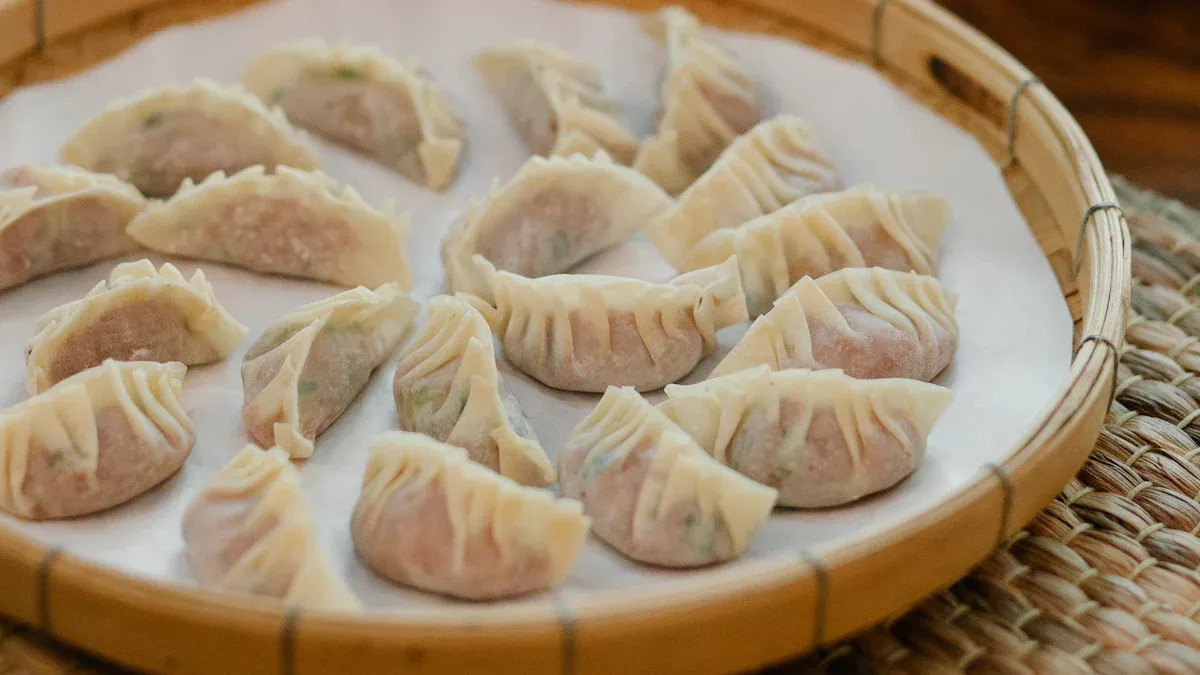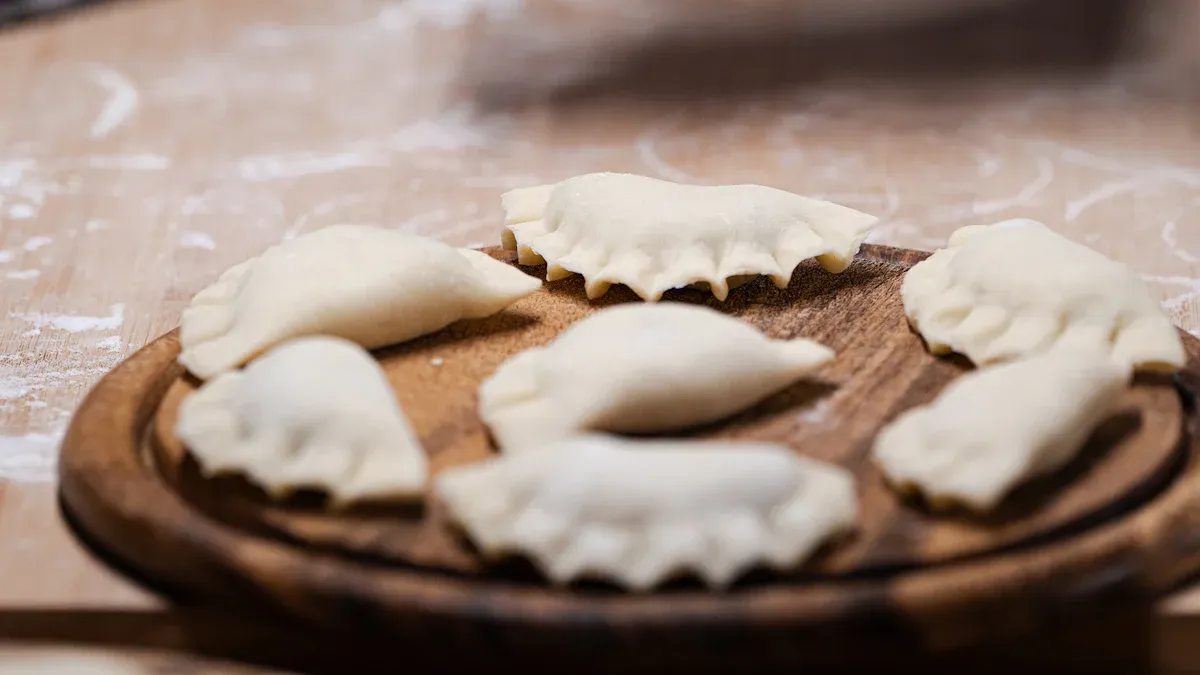
Bulk buyers often face the challenge of balancing cost-efficiency with production demands. For large-scale operations, factors like production speed, labor savings, and consistent quality play a critical role in profitability. Investing in bulk food equipment, such as a commercial dumpling maker, can streamline processes, reduce manual effort, and ensure uniformity in every batch.
Key Takeaways
- A commercial dumpling maker works faster, helping businesses handle big orders easily.
- Buying a commercial dumpling maker saves money over time by cutting worker costs and reducing wasted materials.
- Making dumplings by hand allows for custom designs and special orders but can be slower and less consistent.
Benefits of Using a Commercial Dumpling Maker

Increased Production Speed
A commercial dumpling maker revolutionizes the production process by automating repetitive tasks. These machines transform dough and fillings into perfectly formed dumplings at remarkable speeds. Designed for high-volume operations, they can produce hundreds or even thousands of dumplings per hour. This efficiency allows businesses to meet large-scale demands without delays. By eliminating manual shaping, the machine ensures faster turnaround times, which is critical for bulk buyers aiming to optimize their supply chain.
Consistency in Quality and Appearance
Uniformity is a hallmark of professional food production. A commercial dumpling maker guarantees consistent size, shape, and filling distribution in every dumpling. This precision enhances the visual appeal of the product and ensures a uniform cooking experience. Customers value consistency, especially in large orders, as it reflects the brand’s commitment to quality. For businesses, this reliability reduces the risk of customer dissatisfaction and strengthens their reputation in competitive markets.
Labor Cost Reduction
Manual dumpling production requires a significant workforce, especially for bulk orders. A commercial dumpling maker minimizes this dependency by automating labor-intensive tasks. Businesses can reallocate their workforce to other critical areas, such as packaging or quality control. This shift not only reduces labor costs but also improves operational efficiency. Over time, the savings on wages and training expenses contribute to a more sustainable business model.
Long-Term Cost Savings
While the initial investment in a commercial dumpling maker may seem substantial, the long-term financial benefits outweigh the upfront cost. The machine’s durability and efficiency lead to reduced operational expenses over time. By lowering labor costs and minimizing material waste, businesses can achieve higher profit margins. Additionally, the machine’s ability to handle high production volumes ensures scalability, making it a valuable asset for growing enterprises.
Drawbacks of Commercial Dumpling Makers
High Initial Investment
Purchasing a commercial dumpling maker requires a significant upfront financial commitment. High-quality machines, designed for large-scale production, often come with a premium price tag. For small or medium-sized businesses, this initial expense can strain budgets. While the long-term benefits may justify the cost, the initial investment may deter businesses with limited capital. Additionally, the need for accessories or complementary equipment can further increase the overall expenditure.
Maintenance and Operational Costs
Operating a commercial dumpling maker involves ongoing expenses. Regular maintenance is essential to ensure optimal performance and prevent breakdowns. Spare parts, lubricants, and professional servicing contribute to these costs. Energy consumption also adds to operational expenses, especially for high-capacity machines. Businesses must allocate resources for training staff to operate and maintain the equipment effectively. Neglecting these aspects can lead to inefficiencies and unexpected repair costs.
Limited Customization Options
A commercial dumpling maker excels in producing uniform products but may lack flexibility in customization. Businesses that prioritize unique recipes or intricate designs may find these machines restrictive. Adjusting settings to accommodate different dough textures or fillings can be challenging. For brands emphasizing artisanal appeal or catering to niche markets, this limitation may impact their ability to meet customer expectations. Manual methods often offer greater adaptability in such cases.
Advantages of Handmade Dumpling Production

Flexibility in Recipes and Customization
Handmade dumpling production offers unparalleled flexibility in adapting recipes and designs to meet specific customer preferences. Businesses can experiment with diverse fillings, dough textures, and shapes to create unique products that cater to niche markets or seasonal demands. This adaptability allows brands to stand out in competitive markets by offering personalized options.
| Feature | Description |
|---|---|
| Customizable Mold | The forming mold can be tailored to specific client needs, including size, shape, and edge pattern. |
| Unique Product Creation | Clients can create unique products that reflect their specific ingredient characteristics. |
This level of customization is particularly valuable for businesses targeting gourmet or artisanal food enthusiasts. By tailoring each batch to customer specifications, companies can build stronger relationships and foster brand loyalty.
Lower Initial Costs
Handmade production requires minimal upfront investment compared to purchasing commercial equipment. Businesses can start operations with basic tools and a skilled workforce, avoiding the financial burden of high-tech machinery. This approach is especially advantageous for small-scale producers or startups with limited capital.
The absence of significant equipment costs also reduces financial risk. Companies can allocate resources to other areas, such as marketing or ingredient sourcing, to enhance overall business growth. For entrepreneurs testing new markets, handmade production provides a cost-effective entry point.
Artisan Appeal and Quality Control
Handmade dumplings carry an artisan appeal that resonates with customers seeking authenticity and craftsmanship. Each dumpling reflects the skill and dedication of the maker, creating a sense of exclusivity. This handcrafted quality often justifies premium pricing, attracting customers willing to pay more for superior taste and presentation.
Additionally, handmade production allows for meticulous quality control. Workers can inspect each dumpling during the process, ensuring consistency and addressing imperfections immediately. This hands-on approach minimizes defects and enhances customer satisfaction, reinforcing the brand’s reputation for excellence.
Challenges of Handmade Dumpling Production
Labor-Intensive Process
Handmade dumpling production demands significant manual effort. Workers must prepare dough, measure fillings, and shape each dumpling by hand. This process requires precision and attention to detail, which can be physically taxing over long hours. For businesses handling bulk orders, the need for a large, skilled workforce becomes unavoidable. Training new employees to meet quality standards adds to the operational burden.
Note: Labor-intensive methods often lead to slower production rates, making it difficult for businesses to meet tight deadlines or sudden spikes in demand.
Scalability Issues
Scaling up handmade production presents logistical challenges. As order volumes increase, businesses must hire additional staff, expand workspace, and invest in more raw materials. These adjustments often result in higher operational costs. Unlike automated systems, handmade methods lack the efficiency to handle exponential growth.
- Key Limitations of Scalability in Handmade Production:
- Increased dependency on human labor.
- Limited ability to maintain consistent output during peak seasons.
- Higher risk of delays due to workforce shortages or inefficiencies.
For businesses aiming to grow, these constraints can hinder their ability to compete in larger markets.
Inconsistent Quality in Bulk Production
Maintaining uniformity in handmade dumplings becomes increasingly difficult as production scales up. Variations in size, shape, and filling distribution are common when multiple workers handle the process. These inconsistencies can affect the cooking process and overall customer satisfaction.
Customers often expect uniform products, especially in bulk orders. Inconsistent quality may lead to complaints, returns, or damage to the brand’s reputation.
Handmade production, while artisanal, struggles to meet the consistency standards required for large-scale operations.
Comparative Analysis: Commercial Dumpling Maker vs. Handmade
Cost-Effectiveness for Bulk Buyers
For bulk buyers, cost-effectiveness depends on balancing initial investment with long-term savings. A commercial dumpling maker requires a higher upfront cost but reduces labor expenses significantly over time. Businesses producing large volumes benefit from this automation, as it minimizes material waste and optimizes production efficiency. Handmade production, on the other hand, involves lower startup costs but incurs higher ongoing labor expenses. This method suits smaller operations or businesses prioritizing flexibility over scalability.
Efficiency and Scalability
Efficiency and scalability are critical for meeting growing demand. A commercial dumpling maker excels in high-volume production, delivering consistent results at remarkable speeds. This capability allows businesses to scale operations without proportional increases in labor or workspace. Handmade production, while adaptable, struggles to match this efficiency. Scaling up requires additional staff and resources, which can lead to operational bottlenecks during peak periods.
Quality and Customization Trade-Offs
Quality and customization often involve trade-offs between automation and manual methods. A commercial dumpling maker ensures uniformity in size, shape, and filling distribution, which enhances product consistency. However, it may limit customization options for unique recipes or intricate designs. Handmade production offers greater flexibility, allowing businesses to tailor products to specific customer preferences. This approach appeals to niche markets but may result in inconsistent quality during bulk production.
Long-Term Business Implications
The choice between automated and handmade production impacts long-term business strategies. Investing in a commercial dumpling maker supports scalability and operational efficiency, making it ideal for businesses targeting large-scale markets. Handmade production aligns with brands emphasizing artisanal appeal and customization. However, its labor-intensive nature may hinder growth potential. Businesses must evaluate their goals, market demands, and resources to determine the most sustainable approach.
Choosing between a commercial dumpling maker and handmade production depends on business priorities. Bulk buyers should weigh the benefits of automation, such as scalability and efficiency, against the flexibility and artisan appeal of handmade methods.
Tip: High-volume operations benefit from automation, while niche markets thrive on customization. Align production methods with customer expectations and long-term goals for optimal results.
FAQ
What is the average lifespan of a commercial dumpling maker?
With proper maintenance, a high-quality commercial dumpling maker can last 8–10 years. Regular servicing and correct usage significantly extend its operational life.
Can a commercial dumpling maker handle different types of fillings?
Yes, most machines accommodate various fillings, including meat, vegetables, and mixed options. Adjusting the settings ensures optimal performance for different textures and consistencies.
Is it possible to switch between dumpling sizes on the same machine?
Many commercial dumpling makers include adjustable molds, allowing users to produce dumplings in multiple sizes. This feature enhances versatility for diverse customer demands.
Post time: Mar-28-2025

